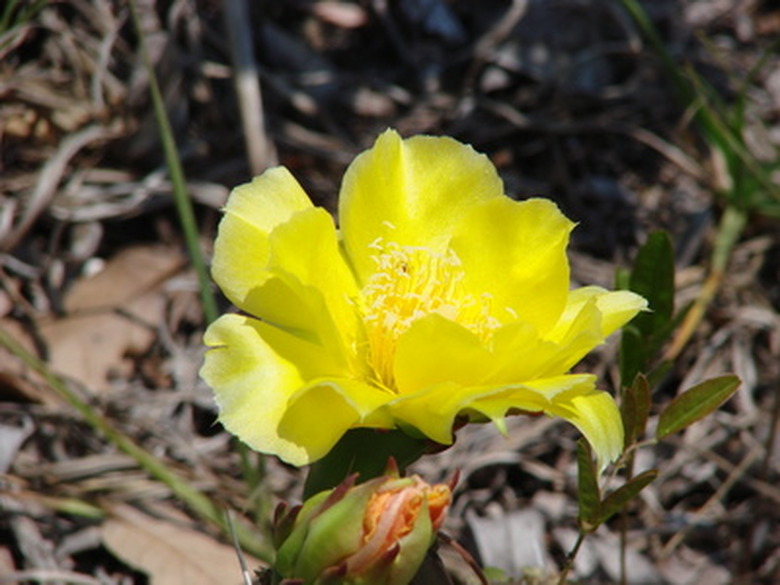Cactus Plants That Grow In Florida
Some of Florida's native cacti, including the semaphore and the key tree cacti of the Florida Keys, are verging on extinction because of land development and the invasion of cactus-eating caterpillars (Cactoblastis cactorum). The Sunshine State's gardeners, however, still have a wide choice of attractive cacti tolerant of Florida's highly humid summers. They range from low-growing plants suitable for small areas to rapid growers for quick garden interest in large landscapes.
Triangle Cactus
Triangle cactus (Acanthocereus tetragonus) is a rapidly growing plant–more than 6 feet per year, according to the Lady Bird Johnson Wildflower Center (LBJWC). It sprawls, leans or climbs over surrounding objects. Its areoles produce clusters of up to eight 1- to 2-inch spines. Growing wild in Florida's coastal area thickets, triangle cactus is a nocturnal bloomer. From July to September, its white, mildly fragrant 2- to 4-inch flowers—attractive to hummingbird moths–open late at night and close at daybreak. Triangle cactus also has edible, shiny red fruit. Cold hardy to 20 degrees F, it likes a partly shady location with sandy, moist soil, but will tolerate heat and drought. Plant where its sharp spines won't endanger passersby.
- Some of Florida's native cacti, including the semaphore and the key tree cacti of the Florida Keys, are verging on extinction because of land development and the invasion of cactus-eating caterpillars (Cactoblastis cactorum).
Devil's Tongue
Devil's tongue (Opuntia humifusa), or smooth prickly pear, is a low-growing perennial (up to 8 inches high) native to Florida's dry, sandy areas. Forming clumps as wide as 3 feet, it has flat green pads and numerous clusters of tiny barbed thorns. These toxic thorns, cautions the LBJ WC, will cause severe skin and eye irritation. From May to July, showy yellow flowers appear along the edges of the plant's pads. Reddish-purple fruit, edible raw or as preserves, follows the blooms. The plant's pads and seeds are also edible. Remove the thorns with a damp cloth or by baking or roasting and peeling the pads before eating. Plant drought and heat-tolerant devil's tongue in full sun and dry, sandy soil.
- Devil's tongue (Opuntia humifusa), or smooth prickly pear, is a low-growing perennial (up to 8 inches high) native to Florida's dry, sandy areas.
- From May to July, showy yellow flowers appear along the edges of the plant's pads.
Night Blooming Cereus
Gardeners in frost-free areas of Florida, says Cornell University's Cooperative Extension, can grow night blooming cereus (Hylocerus undatus). A climbing cactus free of thorns, night blooming cereus is native to Arizona's Sonora Desert. Trained on a fence or trellis, plants may grow to 40 feet. They also work in containers. Night blooming cereus flowers at two-week intervals from midsummer to fall. Plants don't usually bloom until they are at least four years old. Flowering increases yearly after that.
- Gardeners in frost-free areas of Florida, says Cornell University's Cooperative Extension, can grow night blooming cereus (Hylocerus undatus).
- A climbing cactus free of thorns, night blooming cereus is native to Arizona's Sonora Desert.
The cactus buds along its stem edges, with the buds ready to open after a week. The exceptionally fragrant, 7-inch white blooms–similar to magnolias–begin opening at dusk. They often continue unfolding until midnight, wilting as daylight returns. Plant night blooming cereus in a sunny location with well-drained soil. With afternoon shade, this heat-resistant cactus tolerates temperatures exceeding 100 degrees F.
